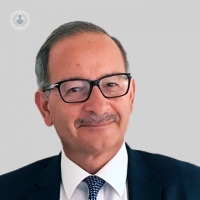Common injuries affecting golfers
Written in association with:Most injuries in golf tend to affect the shoulders, elbows, hands and wrists. The golf swing is a fundamental part of the game and poor swinging techniques, which include over swinging or hitting the ground unintentionally, can contribute to injuries. There are times when a golfer may even fall or get hit by a fast-approaching golf ball, both of which can lead to injury anywhere on the body. We asked Mr Ali Al-Sabti, a leading orthopaedic surgeon, what the most common golf injuries he’s encountered are.


When during swings is injury most likely to occur?
During the various phases of the swing injury can occur. These include the back swing, down swing, impact or the follow through. Let’s take a look at these four different phases and the movements involved.
- The back swing – this part of the swing can cause injuries to the elbows, wrists and shoulders in the long-term. During the back swing, the arms and shoulders move around the axial skeleton - which forms the central axis of the body. Whilst at the top of the swing, the forearm muscle is stretched and the wrists are in maximum radial deviation (the movement of bending the wrist towards the thumb).
- The down swing – during this swing, the weight transfers from the right to the left side. The muscles that are most engaged during this are the pectoralis major (situated in the chest), the subscapularis (near the shoulder joint) and latissimus dorsi (one of the largest muscles in the back). Repetition of this can also lead to wrist, elbow or rotator cuff injury.
- During the impact phase – if the golfer strikes the ground by accident during the swing injuries can occur. It’s the part of the phase where most injuries are likely to happen.
- During the follow through phase - as the body turns, the left forearm rotates to the outside as the right forearm rotates to the inside. Almost all the weight has now moved onto left foot.
Wrist and hand injuries and treatments
Wrist and hand injury is very common in golfers affecting the flexor carpi ulnaris tendon which is the tendon on the inner side of the forearm towards the little-finger. Developing tendinosis (a type of tendon disorder) in that area is not unusual. It can develop on the back of the wrist in the extensor carpi ulnaris muscle – the little-finger side of the forearm. Treatment is quite simple and just requires rest and physiotherapy. Occasionally a steroid injection may be required.
The hamate hook, which is a small carpal bone located in the hand and wrist area, is also a common place to find injuries and can cause pain in the bone. CT scans are needed to see the bone more clearly and if the bone is fractured then surgery is normally required to fix it.
Carpal tunnel syndrome is a common condition which cause numbness, and pins and needles in the wrist. Initial treatment is rest and the use of night splint braces. Steroid injections and surgical intervention may be offered.
Shoulder injuries and treatments
The most common problems are impingement syndrome or rotator cuff tears. Impingement syndrome is where there is inflammation in the tendons from bones in the shoulder. This causes pain, weakness and loss of movement to the shoulders. The rotator cuff, which is an area of tendons and ligaments that supports the arm at the shoulder joint, can sometimes tear or strain. This type of injury is quite common in golfers.
Impingement syndrome can be treated with physiotherapy and a steroid injection. Usually, there is a 70% cure rate. Rotator cuff tears often need surgical intervention to be fixed. Keyhole surgery is normally the chosen procedure and the patient can leave the same day.
Some people report the feeling of a pop in the shoulder or shoulder instability which is not uncommon. There are also some other injuries that can occur due to repetitive overuse. The acromioclavicular joint (a small joint at the top the shoulder) can become damaged over time resulting in stiffness and pain. This can be treated by physiotherapy, steroid injections, and on rare occasions, an excision of the joint may be needed
Elbow injuries and treatments
Golfer’s elbow, also known as medial epicondylitis, is one of the most common injuries and consists of pain inside of the elbow due to inflammation of the tendons which connect to the bone of the elbow.
Tennis elbow, also known as lateral epicondylitis, is sometimes seen in golfers and can be due to strenuous overuse of muscles in the forearm from gripping the club too tightly.
Treatment of both golfer’s elbow and tennis elbow are very similar. Initially, a steroid injection and physiotherapy are offered. Both of which are usually quite effective. Surgery may be needed if there is no improvement following the above treatment.
How to prevent these injuries
Most injuries can be avoided by using preventive measures such as warming up, conditioning and proper swing techniques.
Warming up and stretching before the game is always very important. It generates more oxygen and increases the temperature and blood flow to the muscles which helps limit your chances of injuring a muscle or tendon.
Golfers also need to routinely strengthen their rotator cuff and scapular muscles. They should also ensure that correct swinging techniques are used.
If you’re a golfer and need treatment for an injury like one of these, contact Mr Ali Al-Sabti by going to his profile and booking a consultation.


